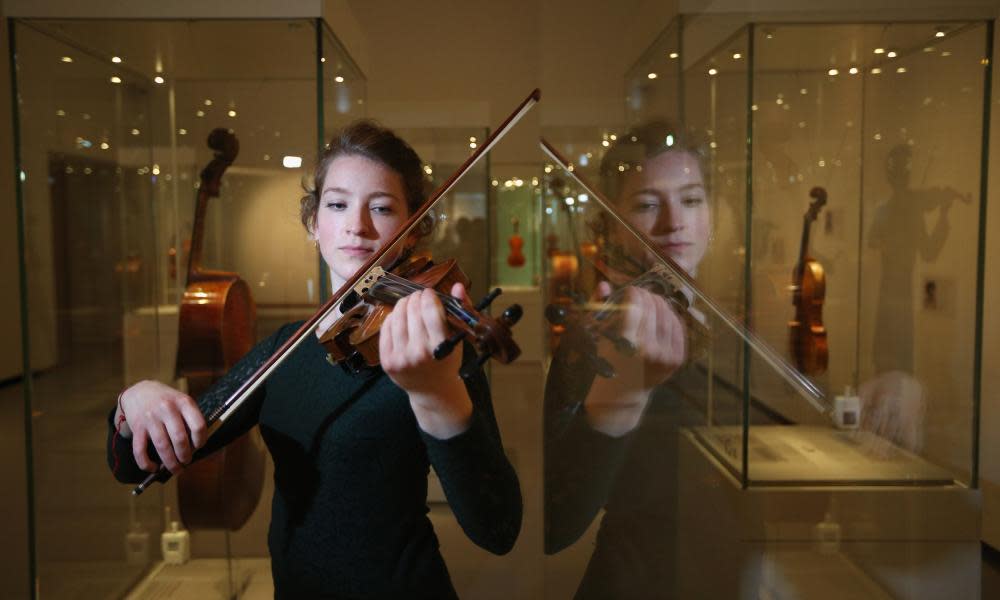Scientists find secret behind sweet sound of Stradivarius violins

The violins made by the Italian masters Andrea Amati and Antonio Stradivari are celebrated as the finest ever made, but the secret behind their perfect sound has mystified experts for centuries.
Now scientists in Taiwan believe they have hit on an answer. Using software normally reserved for speech analysis, they found that violins from the two Cremonese luthiers mimic aspects of the human voice, a feature they argue adds to the instruments’ exceptional musical quality.
The scientists recorded a professional violinist playing 15 antique instruments at Taiwan’s Chimei Museum and compared the acoustic signatures with those from 16 male and female vocalists who were recorded singing English vowel sounds.
The researchers found that the early Italian instruments produced human-like “formants”, the harmonic tones that correspond to resonances in the vocal tract. Specifically, the Amati violins produced formants similar to those from bass and baritone singers, while the Stradivari instruments had higher-frequency formants, closer to those of tenors and contraltos.
Hwan-Ching Tai, an author on the study at the National Taiwan University, said Stradivari violins are often described as having “brightness” and “brilliance”, both qualities that could be rooted in the higher-frequency tones that make the instruments sound closer to female voices.
“Some Stradivari violins clearly possess female singing qualities, which may contribute to their perceived sweetness and brilliance,” he said. Female singers tend to have higher-frequency formants than males because their vocal tracts are shorter.
Born in 1505, Andrea Amati is credited with inventing the modern violin. His instruments were so successful that the designs were copied for generations. Antonio Stradivari, who was born 139 years later, inherited Amati’s methods and designs and improved on them until he was manufacturing instruments now widely considered to be unsurpassed.
Tai and his colleagues decided to compare the acoustic features of antique violins with those from singers after reading a quote from Francesco Geminiani, a famous baroque composer and author of The Art of Playing on the Violin, one of the most influential violin manuals ever published. Writing in the 1751 book, Geminiani described the secret of violin performance as “giving the instrument a tone that shall in a manner rival the most perfect human voice”.
Tai suspects the uncanny resemblance between early Italian violins and human voices is not an accident. “The early violin was not a solo instrument but an accompaniment to songs and dances,” he said. “It is conceivable that Andrea Amati may have wanted to build a string instrument that could imitate human voices to blend into such music.”
Tai, whose work is published in the Proceedings of the National Academy of Science, is not the first scientist to search for a theory of the Italian masters’ success. Other researchers have claimed that the secret lies in the varnish, or in the density of the wood, even as others have shown that concert audiences actually prefer the sound of modern violins.
Christian Lloyd, managing editor of the Strad magazine, said violinists often talk about their instruments with words typically used to describe voices. “People talk about their violins being lively, sweet or mellow,” he said. “If they don’t like the sound, they’ll say it’s metallic, tinny or steely. The worst thing you can call an instrument is dead.”
In the past, Lloyd said, violin makers kept their manufacturing methods close to their chests, so secrets, whether important or not, were part of the business. But today, manufacturers are far more open and share details of their designs and methods. As a result, he said, the best instruments made today are on a par with Stradivari’s.
For the latest study, Tai looked only at antique violins, raising the question of how modern violins would have fared in comparison. “Who’s to say the modern instruments won’t give you the same qualities?” Lloyd said. “We don’t think there are secrets of the Stradivarius.”

 Yahoo News
Yahoo News 
